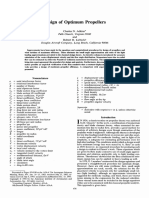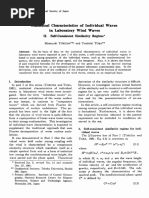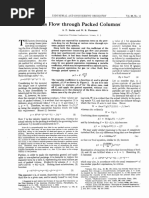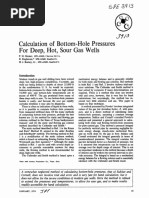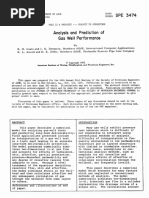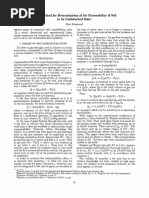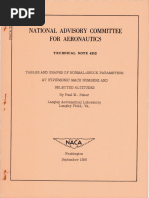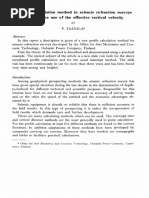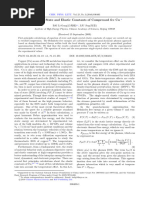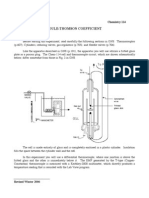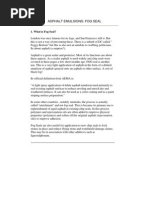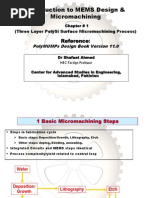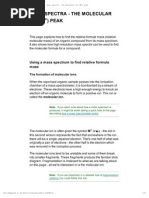Determination of Acoustic Velocities For Natural Gas
Determination of Acoustic Velocities For Natural Gas
Uploaded by
Vibhuti BhargavaCopyright:
Available Formats
Determination of Acoustic Velocities For Natural Gas
Determination of Acoustic Velocities For Natural Gas
Uploaded by
Vibhuti BhargavaOriginal Title
Copyright
Available Formats
Share this document
Did you find this document useful?
Is this content inappropriate?
Copyright:
Available Formats
Determination of Acoustic Velocities For Natural Gas
Determination of Acoustic Velocities For Natural Gas
Uploaded by
Vibhuti BhargavaCopyright:
Available Formats
Determination of Acoustic
Velocities for Natural Gas
L. K. Thomas, SPE-AIME, Phillips Petroleum Co.
R. W. Hankinson, Phillips Petroleum Co.
K. A. Phillips, Phillips Petroleum Co.
Introduction
Some uses of acoustic velocities for natural gas are Calculation of Acoustic Velocity
to determine liquid levels in gas wells and to locate Starting from the equation for the speed of sound in
hydrate freezes, lost 'pigs', or other obstructions in a compressible fluid 9
gas pipelines. These distances can be calculated from
well defined acoustic records (Fig. 1a) by associating
the number of pipe sections with their corresponding
Vt = [(ap) ]~
':I
up s
' • (2)
lengths. If, however, an uninterpretable acoustic it is possible to derive the following equation for a
record (Fig. 1b) is obtained, or if the lengths of the real gas (see Appendix).
pipe sections of a given flow string are unknown,
]~
distance between the shot deflection and the reflecting
surface can be obtained by integrating the relation- Vt-
_ [ gczKRT
P
1-- -
(az) . (3)
ship between velocity distance and time z ap T
dx Eq. 3 can also be expressed in terms of the isentropic
v = dt (1) expansion coefficient, n, since
K
The utility of this technique depends upon one's (4)
ability to calculate acoustic velocities and to measure
n = -1 _-p_(--,--oz~) , .
system variables such as gas gravity· or composition, z ap T
temperature, temperature gradient and pressure. Making this substitution yields
In the past, 1 acoustic velocities have been calcu-
lated from an approximate relationship involving
Vt = \}gcznRT . (5)
atmospheric heat capacity ratios rather than ratios To compute the velocity of sound in a real gas from
that are a function of pressure .. As has been pointed either Eq. 3 or Eq. 5, it is necessary to know the PVT
out, 8 this approximate relationship provides a good behavior of the gas and the variation of the heat
working equation for calculating acoustic velocities capacity ratio with temperature and pressure. To
at low pressure ranges but should not be used at accomplish this, an equation of state for natural gas
higher pressures. was developed.
The purpose of this work is to present a method
for rigorously calculating acoustic velocities for natu- Benedict-Webb-Rubin Equation
ral gas over a broad range of temperatures, pressures Of State for Natural Gas
and gas gravities. An equation of state based on the well known eight-
Acoustic velocities for natural gas are calculated as a function of temperature, pressure,
and gas gravity. The method is based on.a generalized equation of state for natural gas that
may also be used to calculate a number of thermodynamic properties such as specific
internal energy and isentropic expansion.
JULY,_ 1970 889
constant Benedict-Webb-Rubin 7 (BWR) equation was
developed for natural gas. A comprehensive treatment
of this work was published earlier5 and only a brief
summary is presented here.
Expressed in pseudoreduced form, the BWR equa-
tion of state is given by
Pp·r = ~;:. + (Bor Tpr - Aor - Co/Tv/)/Vpr 2
+ (br TP1' - a1.)/Vp1· 3 + a1. a1./Vpr6
TUBING COLLAR UNINTERPRETABLE + [c,r (1 - y1./Vp1· 2 ) e-"Yr/Vpr
2
]/Vpr 3 Tp/·
REFLECTIONS TUBING COLLAR
(6)
REFLECTION
The pseudoreduced volume is defined as
v (7)
Vvr = RT ' ..
_ _'fi_C
Ppc
and is related to Tvn Pvr and gas compressibility fac-
tor, z, by the following equation:
LIQUID REFECTION (8)
A
The basic gas compressibility data 2 as presented
8
in tabular reduced form by Poettmann and Carpenter6
Fig. !-Acoustic records. were used to evaluate the reduced BWR coefficients;
Two sets of coefficients were developed to obtain the
desired accuracy over the entire Pvr range from 0.4
to 15. The first set of reduced BWR coefficients,
750
Table 1, is applicable for Pvr from 0.4 to 5 and the
F 700 second set applies to the range of Pvr from 5 to 15.
141.
a:
::;::)
I-
650 The low reduced temperature limit of the correlation
<
a: is Tvr = 1.1.
1.41 600
0...
::::!!
w
I- 550 Correlation of Pseudocritical Temperature and
.....1
500
Pseudocritical Pressure with Gas Gravity
<
u
i= Data relating gas composition to gravity were obtained
a:
u
450
on 84 casinghead gas wells from the Phillips Natural
0
0
::;::)
400 Gas and Gasoline Dept. and were used to extend the
1.41
U)
0... 350 Tpc = 170.491 +307.344 ?'g NGPSA 2 • 4 correlations for the critical properties of
300 natural gas vs gas gravity. The Phillips data were all
.5 .6 .7 .6 .9 1.0 1.1 1.2 1.3 1.4 1.5 1.6 1.7 1.8 recent (less than 7 years old) and represent wells
GAS GRAVITY from different fields in several states. They were lim-
Fig. 2-Pseudocritical temperature as a ited to those points analyzed by gas chromatography
function of gas gravity. rather than by wet analysis.
The data from the well logs were processed as
follows:
1. The pseudocritical temperatures and pseudo-
680
< critical pressures at each point were calculated using
~ 670
w'
a:
::;::) 660
U)
U)
w
a: 650 TABLE I-COEFFICIENTS FOR THE REDUCED
a...
.....1
BENEDICT-WEBB-RUBIN EQUATION OF
< 640
u STATE FOR NATURAL GAS
i= 630
a:
u Coefficient Pprfrom 0.4 to 5.0 Ppr from 5.0 to 15.0
0
0 620 a,. 0.001290236 0.0014507882
::;::)
w
U)
a... 610 Aor 0.38193005 0.37922269
br 0.022199287 0.024181399
.6 .7 .8 .9 1.0 1.1 1.2 1.3 1.4 1.5 1.6 1.7 1.8 Bor 0.12215481 0.11812287
Cr -0.015674794 0.037905663
GAS GRAVITY 0.027271364 0.19845016
Cor
Fig. 3-Pseudocritical pressure as a ar 0.023834219 0.048911693
function of gas gravity. Yr 0.43617780 0.0631425417
890 JOURNAL OF PETROLEUM TECHNOLOGY
a weighted molar average of the pure component Ao =A or R 2 Tpc 2/Ppc , (18)
criticals.
b = br R 2 Tpc 2/Ppc 2 (19)
(9)
Bo = BarR Tpc/Ppc (20)
(10). C = Cr R Tpc /Ppc 2
3 5
(21)
2. Points relating pseudocritical temperature and Co == Cor R 2 Tpc 4 /Ppc , (22)
pseudocfitical pressure to gravity from the Engineer-
ing Data Book 2 • 4 and from Phillips were fit with the a = ar R3 Tpc3/Ppc3 (23)
best equations in the least-squares sense. The resulting y = Y1· R2 Tpc2/Ppc2 (24)
straight-line correlations are shown graphically in
Figs. 2 and 3 and are given by the following equations: Differentiating Eq. 16 yields
cJ7 e-~fv
2
6 [ cJ7
Tpc = 170.491 + 307.344 Yu , (11) C v =Cv 0 +--
.T V C o - -
3 y +· -- y -
Ppc = 709.604 - 58.718 yg . (12)
ce-'YfV2]
(25)
The allowable limits of impurities for the above equa- + 2V '
tions are 3 percent hydrogen sulfide, 5 percent nitro-
gen, or a total impurity content of 7 percent. Outside
these limits, the errors in pseudocritical pressure ex- (26)
ceed the 6 percent expected maximum.
The low-pressure heat capacity for natural gas can be
Evaluation of the Ratio of Heat evaluated as a function of temperature and gas gravity
Capacities for Natural Gas from the following equation5
To evaluate the ratio of heat capacity, K, for natural . Cp 0 =A+ BT + CG + DG 2 + E(TG) + FT 2
gas as a function of temperature, pressure and gravity,
it is necessary to relate the specific heat of gas at con- (27)
stant pressure To obtain the foregoing coefficients, 60 hypothetical
mixtures were generated by permuting hydrocarbon
(13) compositions over a gravity range of 0.55 to 2.0.
Molal-average l()w-pressure heat capacities were then
and specific heat at constant volume calculated for these mixtures at several temperatures,
resulting in several hundred data points relating tem-
(14) perature, gravity and molar-average low-pressure heat
capacities. Two sets of coefficients were obtained
to the PVT behavior of the gas. The approach used (Table 2), the first set for the temperature range from
in this work was to evaluate the difference in heat 0 to 200°F and the second set for a broader tem-
capacities from Eq. 15, perature range, 0 to 600°F. The average absolute
2
errors for the correlations were 1.01 and 1.37 percent,
_
Cp - Cv - - T
(.' aT
ap ) v /( ap )
oV T '
(15) respectively.
and the specific heat capacity at constant volume from Discussion of Results
Eq. 14. The specific heat at constant pressure was Acoustic velocities for natUral gas have been calcu-
then calculated by adding the results from Eqs. 14 lated· using the technique described in the previous
and 15. section and are presented in Figs. 4 through 7. These
The derivatives on the right-hand side of Eq. 15 plots represent values of acoustic velocities for natural
can be evaluated from Eq. 6, and Cv can be obtained gas vs pseudoreduced temperature and pseudoreduced
by differentiating the BWR equation for internal pressure for values of gas gravity of 0.6, 0.8, 1.0 and
energy 7 1.2, respectively.
·Figs. 8 through 11 show the relationship between
U = U0 - (A 0 + 3C 0 /T 2 ) __!_
J7 - ~(- 1
-)
2 J72
~5 + ~~ ( ~2
TABLE 2-COEFFICIENTS FOR THE CORRELATION OF
+ a5a ( ) ) LOW-PRESSURE ISOBARIC HEAT CAPACITY FOR
NATURAL GAS AS FUNCTION OF
[ (1 _ e~~/V ) J72 _ e-~v2]
2
TEMPERATURE AND GRAVITY
' . (16)
Temperature Range
0 to 200 oF 0 to 600 oF Units
with respect to temperature at constant volume. A 4.6435 3.7771 T: °F
The BWR coefficients in Eq. 16 are related to. the 8 -0.0079997 -0.0011050 Cp0:8tu/lbmole 0 R
reduced BWR coefficients listed in Table 1 by the c 5.8425 7.5281
following identities: D 1.1533 0.65621
E 0.020603 0.014609
(17) F 9.849 (l0- 6) 0.0
JULY, 1970 891
2300
2200
2100
2000
1900
1800
1700 1400
1600 1300
u
&&I
1500 Cl) 1200
.......
u .......
UJ
Cl')
1400 LL.. 1100
.......
.......
LL..
1300 >
.......
1000
> 1200 u0 900
....... __,
u 1100 &&I 800
0
....J
>
UJ 1000 u 700
> i=
u 900 Cl)
::;:, 600
~ 0
V)
::;:, 2400 ~
0
u 2300
< 1900
2200
2100 1700
2000
1900
1500
1800
1700 1300
1600 5.0 6.0 7.0 8.0 9.0
5.0 6.0 7.0 8.0 9.0
PSEUDO REDUCED PRESSURE, Ppr
PSEUDO REDUCED PRESSURE, Ppr
Fig. 4-Acoustic velocity for 0.6-gravity natural gas. Fig. 6-Acoustic velocity for 1.0-gravity natural gas.
20000,-____,1.0~____2,.0______3,.0______~----~
1900
1600
1500
1400
1300
u
&&I 1200
V)
.......
....... 1100
u LL..
~ > 1000
....... 1-
.......
LL. u0 900
.,.: _, 800
....... &&I
u0 >
700
_, u
&&I i= 600
> aoo Cl)
~
0
~ u 2000
....
Cl) -<
8
~ 1800
2000
1900
1800 1600
1700
1600 1400
1500
1400 1200
5.0 6.0 7.0 8.0 \. 9.0 5.0 6.0 7.0 8.0 9.0
PSEUDO REDUCED PRESSURE, Ppr.
PSEUDO REDUCED PRESSURE, Ppr
Fig. 5-Acoustic velocity for 0.8-gravity natural gas. Fig. 7-Acoustic velocity for 1.2-gravity natural gas.
892 JOURNAL OF PETROLEUM TECHNOLOGY
the approximate expression for the ratio of heat the correlation are: (1) less than 3 percent hydrogen
capacities, sulfide, 5 percent nitrogen or a total impurity content
KO of 7 percent; and (2) reduced temperature greater
K(T,p) ~ (28) than 1.1 and reduced pressures between 0.4 and 15
z ' . with the applicable set of coefficients. Also limiting is
and the rigorously calculated ratio of heat capacities. the fact that the pseudocritical equations were devel-
Figs. 8 and 9 for a gas gravity of 0.6 indicate little oped from casinghead gas data, and should not be
difference in K values for pressures less than 1,000 applied to condensate-bearing gas10 with a gravity
psia, but show wide discrepancies for higher values greater thi:m 0. 8.
of pressure. Figs. 10 and 11 for 0.8-gravity gas also The BWR equation of state can be used to calcu-
show little difference between the approximate and late heat capacity ratios and in tum acoustically cal.:
rigorous values of K at low pressures- 1,000 psia culate distances with an average error of 0. 71 percent.
in Fig. 11 and up to 3,500 psia in·Fig. 10. Discrep-
. ancies inK values above these pressures, however, are Nomenclature
again appreciable. a, Ao, b, Bo,
For.illustration, calculated values of isentropic ex- c, Co, a, y = Benedict-Webb-Rubin coefficients
pansion coefficients are presented in Figs. 12 and 13. ar, Aro' br, Bro' .
Cr, Cro' ar, Yr =reduced Benedict-Webb-Rubin
Conclusions coefficients ·
It is necessary to calculate K as a function of both A, B, C, D, E, F =low-pressure heat capacity coeffi-
temperature and pressure if reliable acoustic velocity cients, Eq. 27
calculations are desired. This is especially true if sys- Cp = specific heat at constant pressure,
tem pressures are in excess of 1, 000 psia. For pres- Btu/lbmole 0 R
sures less than 1,000 psia, K values can be calculated Cp 0 = low-pressure specific heat at con-
with some degree of confidence using the approximate stand pressure, Btu/lbmole 0 R
relationship given by Eq. 28, K(T, p) ~ K 0 /z. Cv = specific heat at constant volume,
A generalized Benedict-Webb-Rubin equation of Btu/lbmole 0 R
state for natural gas has been presented to be used Cv 0 = low-pressure specific heat at con-
for predicting PVT relationships to within the experi- stant volume, Btu/lbmole 0 R
mental accuracy of the available data. The limits for gc = 32.17lbm ft/Obf sec 2)
2 ·0 r-----~~---o--:C:-:-cAL:-::C=UL-:-AT=E:::-0-::-FR::-::0-M-B=wR=-------.
EQUATION OF STATE
1.8 1.8 • CALCULATED FROM· APPROXIMATE
:.::: :.::: RELATIONSHIP. EQN. 28
:;5 1.6 ui
;::: 1.6
t=
u u
;:: 1.4
<C
<C
<..> ~ 1.4
0
1- 1-
;::5 <C
:I: 1.2 ~ 1.2
IJ...
0 G=.6 ......
0 T=60•F o G=.8
t=
<C
0::
1.0 g< 1.0 T=60"f
cr:
.8 .8
.6~~--~--~--~~---L---L--~ __L _ _ J ~~~--~--~-~~~~--~--J---~~
0 1000 2000 3000 4000 5000 6000 7000 8000 9000 10,000 0 1000 2000 3000 4000 5000 6000 7000 8000 9000 10,000
PRESSURE, PSIA PRESSURE, PSIA
Fig. 8-Ratio of heat capacity for 0.6-gravity Fig. 10-Ratio of heat capacity for 0.8-gravity
natural gas at 60°F. natural gas at 60°F.
2.2 .----_;_,_._ _ _ _ _ _ _ _ _ _ _ _ ___,
o CALCULATED FROM BWR o CALCULATED FROM BWR
EQUATION OF STATE EQUATION OF STATE
1.8 • CALCULATED FROM APPROXIMATE
:c: RELATIONSHIP, EQN.28
ui .,;
w 1.8 .... 1.6
t= i=
u u
;:: 1.6 ~ 1.4
<C
<.> <.>
~
1-
<C
..... 1.4 :I: 1.2
:I:
IJ... IJ...
0 0
G=.6 0
0 1.2 1.0
i=
<
T=100•F
~
0::
0::
.8 .8
.6~~--~--~--~~~~---L--~ __L _ _ J .6~~--~--~--~~--~--~--~--~~
0 1000 2000 3000 4000 5000 6000 7000 8000 9000 10,000 0 1000 2000 3000 4000 5000 6000 7000 8000 9000 10,000
PRESSURE, PSIA PRESSURE, PSI A
Fig. 9-Ratio of heat capacity for 0.6-gravity Fig. 11-Ratio of heat capacity for 0.8-gravity
natural gas at 100°F. natural gasat 100°F.
JULY, 1970 893
H =specific enthalpy, Btu/lbmole tion procedures presented here. We also express our
K =ratio of specific heats, Cp/Cv appreciation to Phillips Petroleum Co. for permission
K 0 = low-pressure ratio of specific to publish this paper.
heats, Cp 0 /Cv 0
n = isentropic expansion coefficient References
p = pressure, psia 1. Andsager, R. L., and Knapp, R. M.: "Acoustic Determi-
Ppc = pseudocritical pressure of a gase-
nation of Liquid Levels in Gas Wells", J. Pet. Tech. (May,
1967) 601-605.
ous mixture, psia 2. Brown, G. G., Katz, D. C.,. Oberfell, G. G. and Alden,
Pp1· = pseudoreduced pressure R. C.: "Natural Gasoline and the Volatile Hydrocarbons",
R =gas constant NGAA, Tulsa, Okla. (1948).
= 1,545 ft-lbr/(lbmole 0 R)/mole- 3. Edmister, W. C.: Applied Hydrocarbon Thermodynamics,
Gulf Publishing Co., Houston, Tex. ( 1961) 1, 58.
cular weight, in Eqs. 3, 5, 4. Engineering Data Book, Natural Gas Processors Suppliers
A-12, and A-14 Assn., Tulsa, Okla. (1957 and 1966).
= 10.73 psi cu ft/(lbmole 0 R) in 5. Hankinson, R. W., Thomas, L. K. and Phillips, K. A.:
Eqs. 7, and 17 through 24 "Predict Natural' Gas Properties", Hydrocarbon Proces-
sing, Gulf Publishing Co., Houston, Tex. (April, 1969)
= 1.987 Btu/(lbniole 0 R) in Eq. 26 106.
S = specific entropy, Btu/lbmole 0 R 6. Poettmann, F. H. and Carpenter, P. G.: "The Multiphase
T = temperature, °F, 0 R Flow of Gas, Oil and Water Through Vertical Flow
Strings", ])rill. and Prod. Prac., API (1952) 257.
T c = critical temperature, 0 R 7. Sage, B. H.: Thermodynamics of Multicomponent Sys-
Tpc = pseudocritical temperature of a tems, Reinhold Publishing Co., New York (1965) 218.
gaseous mixture, 0 R 8. Thomas, L. K.: "A Review of the Acoustic Determination
Tpr = pseudoreduced temperature of Liquid Levekin Gas Wells", J. Pet. Tech. (Aug., 1968)
784-785.
U -= specific internal energy, Btu/lb-
9. Smith, J~ M. and Van Ness, H. C.: lntroductipn to
mole Chemical Engineering Thermodynamics, McGraw-Hill
U 0 = low-pressure specific internal en- Book Co., Inc., New York (1959) 251.
ergy, Btu/lbmole 10. Katz, D. L,, Cornell, D., Kobayashi, R., Poettmann, F. H.,
Vary, J. A., Ellenbaas, J. R. and Weinaug, C F.: Hand-
v =velocity, ft/sec book of Natural Gas Engineering, McGraw-Hill Book
v1 = acoustic velocity in a real gas, ft/ Co.,"Inc., New York (1959) 111.
sec
V = specific volume, cu ft/lbmole APPENDIX
V pr = pseudoreduced volume
x = distance, ft Derivation of Acoustic Velocity in a Real Gas
Yi = mole fraction of component i The equation for the speed of sound in a real com-
z = gas compressibility factor pressible fl.uid 9 is given by Eq. A-1:
y 9 = gas gravity referred to air = 1.0
p = density, Ibm/cu ft (A-1)
Subscripts Expressing Eq. A-1 in terms of specific volume we
p =pressure have
S =entropy
T = temperature . VJ =[ (A-2)
V =volume
WritingS as a function of T and p yields
Acknowledgments
We wish to thank Northern Natural Gas Co. for sup- · ds = ( as ). dT +(~) dp (A-3)
plying the field data necessary for testing the calcula- aT fJ op T
6.0
6.0
,_- 5.0
5.0 ~
"'
,_.- :z
:z ~ 4.0
w ~
:z 4.0
0 u
o CALCULATED FROM BWR
~
0:: 3.0
0
a: EQUATION OF STATE
u
3.0 1-
G=.8
0:: o CALCULATED FROM BWR ~ 2.0
0 ~
a: EQUATION OF STATE
1- 2.0
G:6
~ 1.0
1.0
O0 1000 2000 3000 4000 5000 6000 7QOO 8000 9000 10,000
1000 2000 3000 4000 5000 6000 7000 8000 9000 10.000 PRESSURE. PS lA
PRESSURE, PSIA
Fig. 13-lsentropic exponent, n, for 0.8-gravity
Fig. 12-lsentropic exponent, n, for gravity natural gas. natural gas.
894 JOURNAL OF PETROLEUM TECHNOLOGY
60 ap ) _ Cp ( ap ) _ K ( ap ) (A-8)
( av s - Cv aV + - oV T
-;n
I-
z 50 For a real gas,
0c...
LL.
0 pV = zRT (A-9)
0::
LLI 40
cD
::::!: therefore,
:::::>
~
>-
u
z
LLI
30
( ~)
av T
= _ _p_ + RT(~) (
v · v ap 'l' av
op) . (A-10)
T
:::::>
0
:~) r
LLI
0:
LL. 20 Solving for ( yields
LL.I
>
i=
<(
.....1
:::::>
p
10
( op) -
::::!:
:::::>
u
v (A-ll)
oV r - - l _ _.!!_(~)
1.0 2.0 z ap T
PERCENT ERROR
Combining Eqs. A-2, A-8, A-9 ahd A-ll gives the
Fig. 14-Frequency of error between computed ~nd desired result.
experimental well depths for 57 data points.
Dividing the above equation by dV and assuming
constant entropy for the newly formed derivatives
gives
vf =
"1 -_.!!_(~)
I K(T,
Z
p) z RT
_Gp T
Eq. A-12 can also be expressed in terms of the isen-
(A-12)
(*)p(*)R tropic expansion coe:fficient3
(A-4)
_-Pv( oVap) s
( ~~ )T n- ' . (A-13)
The terms on the right-hand side of Eq. A-4 can also by combining-Eqs. A-2, A-9 and A-13. We then have
be written as follows:
vf = ynzRT . (A-14)
(A-5) Inclusion of the gravitational constant, gc, in Eqs.
A -12 and A -14 is required to make the units con-
as) as ) sistent with the nomenclature. JPT
( av T _ T ( av 'I'
(A-6)
( ~)
Cv '·
Original manuscript received in Society of Petroleum Engineers
aT v office Aug. 6, 1969. Revised manuscript received April 6, 1970.
Paper (SPE 2579) was presented at SPE 44th Annual Fall Meeting,
held in Denver, Colo., Sept. 28-0ct. 1, 1969. © Copyright 1970
as ) _ ( aP ) ( av ) (A-7)
( 3P r - av 'I' ap 'I' •
American Institute of Mining, Metallurgical, and Petroleum Engi-
neers, Inc.
This paper will be printed in Transactions volume 249, which
Combining Eqs. A-4 through A-7 yields will cover 1970.
JULY, 1970 895
You might also like
- Motorcycle Maintenance Manual: BenelliDocument485 pagesMotorcycle Maintenance Manual: Benellicalvin tekNo ratings yet
- Cavitation CFD in A Centrifugal PumpDocument7 pagesCavitation CFD in A Centrifugal Pumpazispn99100% (1)
- Analysis of Modified Isochronal Tests To Predict The Stabilized Deliverability Potential of Gas Wells Without Using Stabilized Flow DataDocument19 pagesAnalysis of Modified Isochronal Tests To Predict The Stabilized Deliverability Potential of Gas Wells Without Using Stabilized Flow DataAndreco 210198No ratings yet
- Design of Optimum PropellerDocument7 pagesDesign of Optimum Propellerkarol8037100% (1)
- Determination of Acoustic Velocities For Natural GasDocument7 pagesDetermination of Acoustic Velocities For Natural GasKen NgNo ratings yet
- Fraim 1987Document12 pagesFraim 1987ljNo ratings yet
- Pub 01Document4 pagesPub 01παπαδοπουλοςNo ratings yet
- Determination of A Verage Reservoir Pressure From Build-Up SurveysDocument5 pagesDetermination of A Verage Reservoir Pressure From Build-Up SurveysJunior CedeñoNo ratings yet
- Computational Methods in Petroleum Reservoir SimulationDocument19 pagesComputational Methods in Petroleum Reservoir SimulationDavi Teodoro FernandesNo ratings yet
- A EmissivityAtmospherIRDocument3 pagesA EmissivityAtmospherIRjmloptroNo ratings yet
- Amplification of Pressure Fluctuations Due To Fluid-Structure InteractionDocument11 pagesAmplification of Pressure Fluctuations Due To Fluid-Structure Interactionbaja2014No ratings yet
- Statistical Characteristics of Individual Waves in Laboratory Wind Waves II. Self-Consistent Similarity RegimeDocument2 pagesStatistical Characteristics of Individual Waves in Laboratory Wind Waves II. Self-Consistent Similarity RegimeYoyok SetyoNo ratings yet
- burke1928Document5 pagesburke1928ishtiaqueNo ratings yet
- Spe 14238 Pa - 2Document13 pagesSpe 14238 Pa - 2hijoetigreNo ratings yet
- Kernforschungszentrum Karlsruhe, Institute of Nuclear Reactor Components, Karlsruhe, Fed. Rep. GermanyDocument7 pagesKernforschungszentrum Karlsruhe, Institute of Nuclear Reactor Components, Karlsruhe, Fed. Rep. GermanyenjpetNo ratings yet
- Calculation of Bottom-Hole Pressures For Deep, Hot, Sour Gas Wells PDFDocument8 pagesCalculation of Bottom-Hole Pressures For Deep, Hot, Sour Gas Wells PDFLibya TripoliNo ratings yet
- Theoretical Calculations of The Distribution of Aerodynamic Loading On A Delta WingDocument35 pagesTheoretical Calculations of The Distribution of Aerodynamic Loading On A Delta WingHarsha HarNo ratings yet
- Flapper ValveDocument6 pagesFlapper ValveRicardo GomesNo ratings yet
- GilletDocument5 pagesGilletJuan Carlos PovedaNo ratings yet
- Articulo 8-5 PDFDocument10 pagesArticulo 8-5 PDFMiguel OrtegaNo ratings yet
- Field Method For Determination of Air Permeability of Soil: in Its Undisturbed StateDocument7 pagesField Method For Determination of Air Permeability of Soil: in Its Undisturbed StatemazharNo ratings yet
- Pergamon: Int. J. Multiphase Flow Vol. 20, No. 4, Pp. 739-752, 1994Document14 pagesPergamon: Int. J. Multiphase Flow Vol. 20, No. 4, Pp. 739-752, 1994anellbmcNo ratings yet
- Working With Non-Ideal Gases PDFDocument3 pagesWorking With Non-Ideal Gases PDFpolaris44No ratings yet
- An Efficient Method To Predict Compressibility Factor of Natural Gas StreamsDocument20 pagesAn Efficient Method To Predict Compressibility Factor of Natural Gas StreamsJWC Sales & Services :No ratings yet
- Propagation of VLF Radio Waves in A Model Earth-Ionosphere Waveguide of Arbitrary Height and Finite Surface Impedance Boundary: Theory and ExperimentDocument14 pagesPropagation of VLF Radio Waves in A Model Earth-Ionosphere Waveguide of Arbitrary Height and Finite Surface Impedance Boundary: Theory and ExperimentWhuionoerNo ratings yet
- Gas Natural TransmisionDocument43 pagesGas Natural Transmisionangel3reyesNo ratings yet
- Barov 2000 0402Document12 pagesBarov 2000 0402Particle Beam Physics LabNo ratings yet
- A Cell-Vertex Multigrid Method For The Navier-StokDocument42 pagesA Cell-Vertex Multigrid Method For The Navier-StokludokellypNo ratings yet
- Methods For Sizing Dust Explosion Vent Areas: A Comparison When Reduced Explosion Pressures Are LowDocument9 pagesMethods For Sizing Dust Explosion Vent Areas: A Comparison When Reduced Explosion Pressures Are Lowanon_463510259No ratings yet
- Wake Fraction and Thrust Deduction During Ship Astern ManoeuvresDocument10 pagesWake Fraction and Thrust Deduction During Ship Astern ManoeuvresDexterNo ratings yet
- A Scale-Dependent Cosmology For The Inhomogeneous UniverseDocument3 pagesA Scale-Dependent Cosmology For The Inhomogeneous UniverseedmarNo ratings yet
- Gas Reservoir EngineeringDocument39 pagesGas Reservoir EngineeringStr DesignsNo ratings yet
- Gas Natural Transmision PDFDocument43 pagesGas Natural Transmision PDFRodrigo Vasquez GonzalesNo ratings yet
- Scaling Laws For Single-Phase Natural Circulation LoopsDocument17 pagesScaling Laws For Single-Phase Natural Circulation LoopsGanjar GilaNo ratings yet
- Of of 2nd 1990: p2 p2 ZoDocument3 pagesOf of 2nd 1990: p2 p2 ZoNilesh NagraleNo ratings yet
- Energy Loss of A High Charge Bunched Electron Beam in PlasmaDocument13 pagesEnergy Loss of A High Charge Bunched Electron Beam in PlasmaParticle Beam Physics LabNo ratings yet
- burm2007Document6 pagesburm2007azuchetti5No ratings yet
- Mathematical Model For Control The Plasma PDFDocument4 pagesMathematical Model For Control The Plasma PDFAzizNo ratings yet
- Tech Note 1Document28 pagesTech Note 1sinha.aniruddhaNo ratings yet
- B-Series Propeller PDFDocument63 pagesB-Series Propeller PDFCakra Wijaya Kusuma RahadiNo ratings yet
- Dowdle 1975Document5 pagesDowdle 1975rahimovfuadNo ratings yet
- Surprising Behaviour of The Wageningen B-Screw Series PolynomialsDocument63 pagesSurprising Behaviour of The Wageningen B-Screw Series PolynomialsAJAY LAKSHAMANANNo ratings yet
- Saturation Distribution and Injection Pressure For A Radial Gas-Storage ReservoirDocument5 pagesSaturation Distribution and Injection Pressure For A Radial Gas-Storage ReservoirOluwatosinImisioluwaAjiboyeNo ratings yet
- Viscoelastic Bulk ModuliDocument19 pagesViscoelastic Bulk ModulikevinlimyuanlinNo ratings yet
- On The Low Frequency Elastic Response of A Spherical ParticleDocument8 pagesOn The Low Frequency Elastic Response of A Spherical ParticlesteveNo ratings yet
- Effect of Shear Friction On Solid Flow Through An Orifice (1991)Document5 pagesEffect of Shear Friction On Solid Flow Through An Orifice (1991)池定憲No ratings yet
- Determining The Ratio of Specific Heats of Slash Slash Gases Using Adiabatic OscillationsDocument9 pagesDetermining The Ratio of Specific Heats of Slash Slash Gases Using Adiabatic OscillationsEralyn DorolNo ratings yet
- 1 s2.0 001671426390005X MainDocument14 pages1 s2.0 001671426390005X MainMaryam LawalNo ratings yet
- Equation of State and Elastic Constants of Compressed fcc CuDocument4 pagesEquation of State and Elastic Constants of Compressed fcc CuMuhammad UsmanNo ratings yet
- CFD Simulations of Three-Dimensional Wall Jets in A Stirred TankDocument15 pagesCFD Simulations of Three-Dimensional Wall Jets in A Stirred TankgokulpawarNo ratings yet
- Spyropoulou Stassinaki1978Document19 pagesSpyropoulou Stassinaki1978Tatiana IppolitoNo ratings yet
- Joule-Thomson Coefficient: Experiment T9 Chemistry 114Document4 pagesJoule-Thomson Coefficient: Experiment T9 Chemistry 114truffeloveNo ratings yet
- Deliverability: Testing and Well Production Potential Analysis MethodsDocument97 pagesDeliverability: Testing and Well Production Potential Analysis Methodsvaleh faridNo ratings yet
- SS PsaDocument10 pagesSS PsaAllan A. AlbuquerqueNo ratings yet
- Spe 115 G PDFDocument14 pagesSpe 115 G PDFJuan SantosNo ratings yet
- Investigation of The Dynamic Rating of Tubular Busbars in SubstationsDocument5 pagesInvestigation of The Dynamic Rating of Tubular Busbars in Substationsmohammad gholamiNo ratings yet
- Herrera 1994Document4 pagesHerrera 1994jose.valdes101No ratings yet
- MAE 449 - Aerodynamics Lab 2 - Airfoil Pressure Measurements - NACA 0012Document8 pagesMAE 449 - Aerodynamics Lab 2 - Airfoil Pressure Measurements - NACA 0012Ted StinsonNo ratings yet
- Plastic Pipes XV Paper Cover Blow OffDocument10 pagesPlastic Pipes XV Paper Cover Blow Offmohannad eliassNo ratings yet
- Rotational Zero Point EnergyDocument7 pagesRotational Zero Point EnergySandipan SahaNo ratings yet
- 2A General Survey, Vital Signs, Measurement 2024Document6 pages2A General Survey, Vital Signs, Measurement 2024alharbimanar20No ratings yet
- HE LESSON 1 Family Resources and NeedsDocument17 pagesHE LESSON 1 Family Resources and Needsgregoriojr37No ratings yet
- Asphalt Emulsions: Fog SealDocument5 pagesAsphalt Emulsions: Fog SealYan Hardman HutahaeanNo ratings yet
- Đề-thi-thử-số-1 Khoa Đào Tạo Và Bồi Dưỡng Ngoại NgữDocument7 pagesĐề-thi-thử-số-1 Khoa Đào Tạo Và Bồi Dưỡng Ngoại NgữThảo NguyễnNo ratings yet
- Perfume Formula Worksheet Calculator V2Document22 pagesPerfume Formula Worksheet Calculator V2sulaksana4444No ratings yet
- Tis VRF AcDocument2 pagesTis VRF AcLas PalmasNo ratings yet
- VL Manual enDocument38 pagesVL Manual enahmad rehmanNo ratings yet
- ASME Code For Pressure Piping B31CommitteeDocument5 pagesASME Code For Pressure Piping B31CommitteeAnibal AriasNo ratings yet
- Cu Unjieng e Hijos V Mabalacat Sugar CoDocument1 pageCu Unjieng e Hijos V Mabalacat Sugar Cocmv mendozaNo ratings yet
- The Prayer of Faith by Leonard Boase PDFDocument69 pagesThe Prayer of Faith by Leonard Boase PDF6luke3738No ratings yet
- 2019-Huawei Certificate Training Catalog DBI Face To Face Training 08012019Document27 pages2019-Huawei Certificate Training Catalog DBI Face To Face Training 08012019otuekong ekpoNo ratings yet
- QF12Document3 pagesQF12Ricca BaudinNo ratings yet
- Topic 4 Cable Size and Wiring MethodDocument64 pagesTopic 4 Cable Size and Wiring MethodYuen Chan100% (1)
- PC Based Robot Controlling Using Wireless Communication With ASK ModulationDocument74 pagesPC Based Robot Controlling Using Wireless Communication With ASK ModulationSyam Kumar SNo ratings yet
- Reviewer Depreciation and Depletion Expires PDFDocument64 pagesReviewer Depreciation and Depletion Expires PDFGab Ignacio0% (1)
- Configuration Guide - Interoperating With Cisco Systems v1.00Document38 pagesConfiguration Guide - Interoperating With Cisco Systems v1.00sanajy15880No ratings yet
- Detailed Lesson Plan Grade 12 StemDocument15 pagesDetailed Lesson Plan Grade 12 Stemlibertty lumintacNo ratings yet
- Soal Procedure Kelas 9Document6 pagesSoal Procedure Kelas 9Neo Evolution WonogiriNo ratings yet
- Maths 2024Document4 pagesMaths 2024dctcalappuzhahoNo ratings yet
- 7 M None X R-11/1/21 Religion: RECORDING FORM 1. MR-TD (6-7 Years Old)Document3 pages7 M None X R-11/1/21 Religion: RECORDING FORM 1. MR-TD (6-7 Years Old)Jasmin Kerre Villarin100% (1)
- Ultraform N 2320 003 UNC Q600: Polyoxymethylene (POM)Document2 pagesUltraform N 2320 003 UNC Q600: Polyoxymethylene (POM)Phuoc Thinh TruongNo ratings yet
- Ga of Siemens HT PanelDocument22 pagesGa of Siemens HT PanelSonal ParikhNo ratings yet
- Daily Activities and TimeDocument1 pageDaily Activities and TimeVanessa BuelvasNo ratings yet
- Britax Ecco ValokuvastoDocument26 pagesBritax Ecco ValokuvastoHenri KujalaNo ratings yet
- Upper Intermediate Student's BookDocument152 pagesUpper Intermediate Student's BookAlejandraNo ratings yet
- PolyMUMPs ProcessDocument28 pagesPolyMUMPs ProcessMajid GhaffarNo ratings yet
- Mass Spectra - The Molecular Ion (M+) PeakDocument5 pagesMass Spectra - The Molecular Ion (M+) PeakChong Chui YinNo ratings yet
- Baby Hugs EbookDocument40 pagesBaby Hugs Ebookcaroleb100% (1)
- Fourier SeriesDocument17 pagesFourier SeriesalemuNo ratings yet



